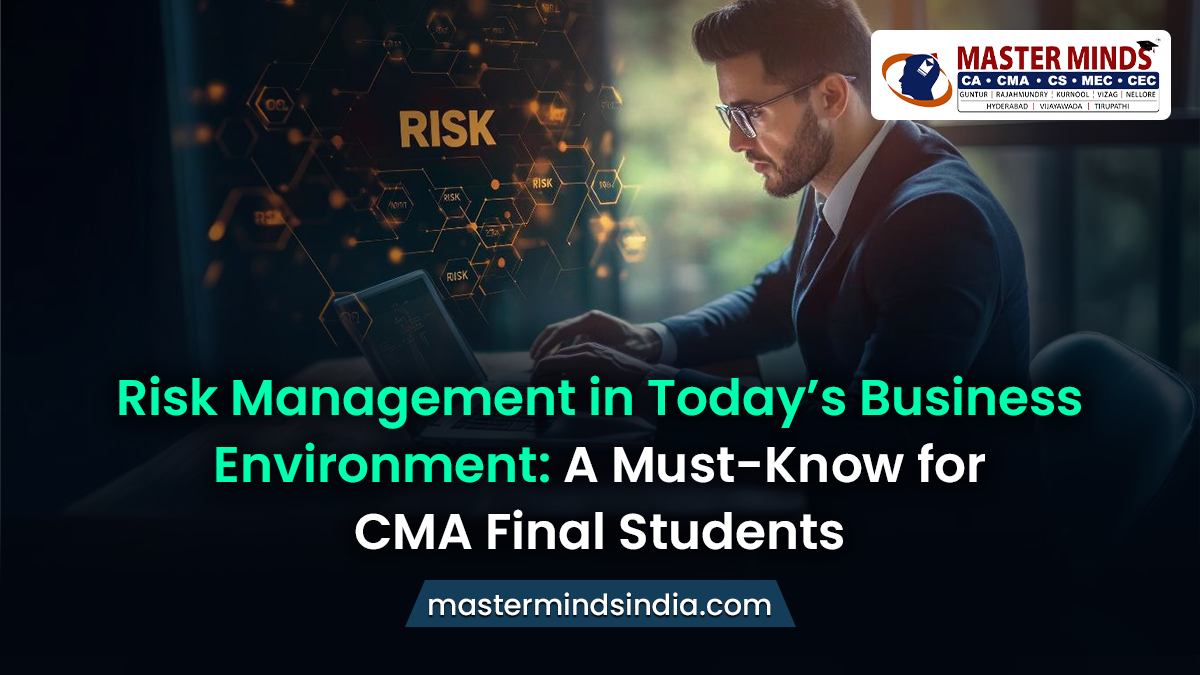Risk Management in Today’s Business Environment: A Must-Know for CMA Final Students

Welcome to Mastermindsindia.com. Risk management is a critical pillar for safeguarding organizational success in the dynamic and often volatile landscape of modern business. For CMA Final students, mastering risk management is not merely an academic requirement but a gateway to becoming adept professionals who can navigate complex challenges and drive sustainable growth.
This guide delves into contemporary risk management techniques and tools, illuminated by compelling real-world case studies, to comprehensively understand this indispensable field.
Understanding the Modern Landscape of Risk Management
In today’s business environment, risk management transcends traditional boundaries. It involves anticipating uncertainties, mitigating potential threats, and leveraging opportunities for strategic advantage. Here’s a look at why risk management is more crucial than ever:
Key Factors:
- Globalization and Complexity: As businesses expand globally, they face multifaceted risks including geopolitical, economic, and operational uncertainties.
- Technological Advances: Rapid technological changes bring both opportunities and risks, necessitating sophisticated risk management strategies.
- Regulatory Environment: Increasingly stringent regulations require businesses to implement robust risk management frameworks to ensure compliance and avoid penalties.
Real-World Example: Consider the global financial crisis of 2008. Many organizations failed to anticipate the systemic risks associated with mortgage-backed securities and derivative instruments. This lack of effective risk management led to catastrophic failures. Modern risk management practices aim to prevent such oversights by employing comprehensive risk assessment and mitigation strategies.
Core Techniques in Contemporary Risk Management
Effective risk management today relies on an arsenal of advanced techniques and tools. Here’s a deep dive into some of the most critical methodologies:
Risk Identification and Assessment:
- Risk Register: Maintain a detailed log of identified risks, including their likelihood and potential impact. This dynamic tool helps in prioritizing risks based on severity.
- SWOT Analysis: Use SWOT (Strengths, Weaknesses, Opportunities, Threats) analysis to identify internal and external risks that could impact the organization.
Risk Mitigation Strategies:
- Avoidance: Alter plans to sidestep potential risks. For example, a company might choose not to enter a volatile market to avoid associated risks.
- Reduction: Implement measures to reduce the impact or likelihood of risks. For instance, investing in cybersecurity can mitigate the risk of data breaches.
- Transfer: Share or transfer the risk to another party, such as through insurance or outsourcing. For example, companies often purchase insurance to cover potential financial losses.
- Acceptance: Acknowledge the risk and prepare to manage its consequences. This approach is often applied to low-impact risks where mitigation is not cost-effective.
Real-World Example: In the tech industry, companies like Google and Microsoft use advanced algorithms and machine learning to predict and manage cybersecurity threats. By investing in these technologies, they can identify potential vulnerabilities and implement proactive measures to safeguard their digital assets.
Risk Monitoring and Review:
- Key Risk Indicators (KRIs): Monitor metrics that signal potential risk events. For example, a sharp decline in market share may indicate emerging competitive threats.
- Risk Audits: Conduct regular audits to evaluate the effectiveness of risk management strategies and adjust them based on new developments.
Real-World Example: The aviation industry exemplifies rigorous risk monitoring. Airlines and manufacturers like Boeing continuously assess and refine their safety protocols, incorporating data from flight simulations, maintenance records, and real-world incidents to enhance safety and mitigate risks.
Learning from the Best and the Worst
Case Study: Toyota’s Recall Crisis
- Background: In 2009-2010, Toyota faced a massive recall crisis due to safety issues with unintended acceleration in its vehicles. The crisis highlighted weaknesses in its risk management practices, particularly in identifying and addressing quality control risks.
- Lessons Learned: Toyota implemented a more robust risk management framework, including enhanced quality control processes, improved communication channels, and a stronger focus on customer safety.
Case Study: The 2017 Equifax Data Breach
- Background: Equifax, a major credit reporting agency, experienced a significant data breach exposing sensitive information of 147 million individuals. The breach underscored deficiencies in its risk management approach, particularly in IT security and data protection.
- Lessons Learned: Equifax overhauled its risk management strategy by investing in advanced cybersecurity measures, conducting comprehensive risk assessments, and enhancing its incident response protocols.
You Can Also Read:
- CA Intermediate New Study Material
- CA Course Duration After 10th, 12th & Graduation
- Tips to Crack CA in First Attempt
- Time-Saving Calculator Tricks for CA Foundation Students
- How to become a CA?
- CA Foundation New Syllabus
- CA Inter New Syllabus
- ICAI CA New Scheme
Crafting Your Risk Management Strategy: A CMA Final Student’s Blueprint
Integrate Risk Management into Your Core Studies:
- Curriculum Focus: Ensure your studies encompass both theoretical knowledge and practical applications of risk management techniques.
- Practical Application: Engage in case studies, simulations, and real-world problem-solving exercises to apply risk management principles effectively.
Develop Analytical and Strategic Skills:
- Analytical Thinking: Sharpen your ability to analyze complex risk scenarios and develop innovative solutions.
- Strategic Insight: Understand how risk management fits into the broader strategic framework of an organization.
Stay Updated with Industry Trends:
- Continuous Learning: Keep abreast of the latest developments in risk management, including emerging risks and innovative tools.
- Professional Networks: Join professional organizations and attend seminars to connect with industry experts and gain insights into best practices.
Mastering Risk Management for a Successful Career
For CMA Final students, mastering risk management is not merely about passing exams but about preparing for a career in which effective risk management is pivotal to organizational success. By understanding contemporary techniques, analyzing real-world case studies, and applying these insights to your studies, you will position yourself as a capable and forward-thinking professional.
Embrace the complexities of modern risk management, and you will emerge well-equipped to navigate the challenges and opportunities of the ever-evolving business landscape.
CA & CMA Online Classes:

